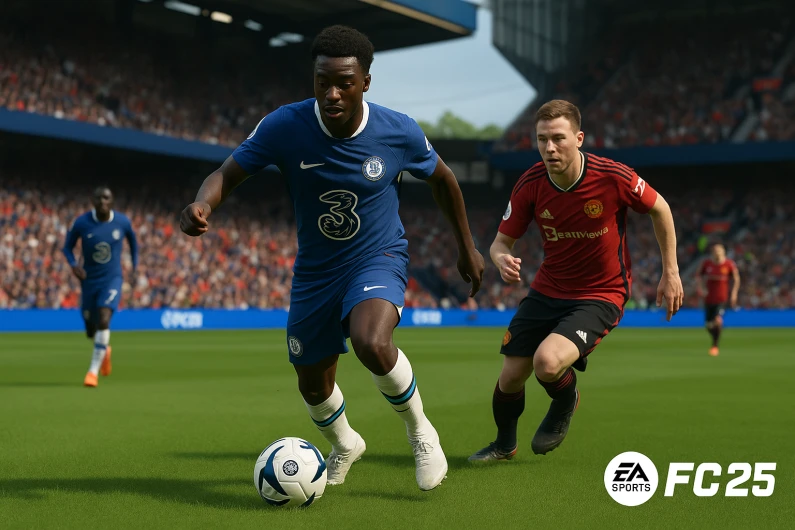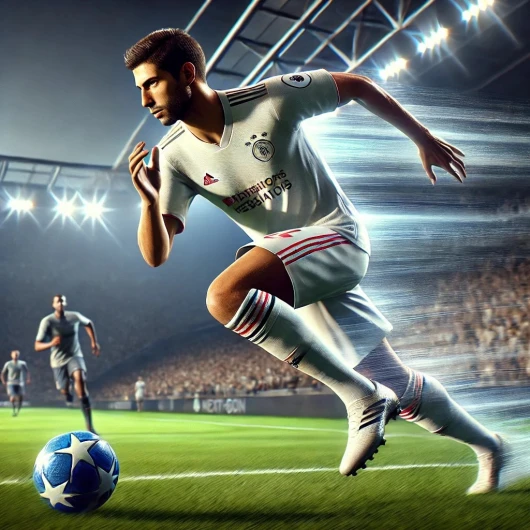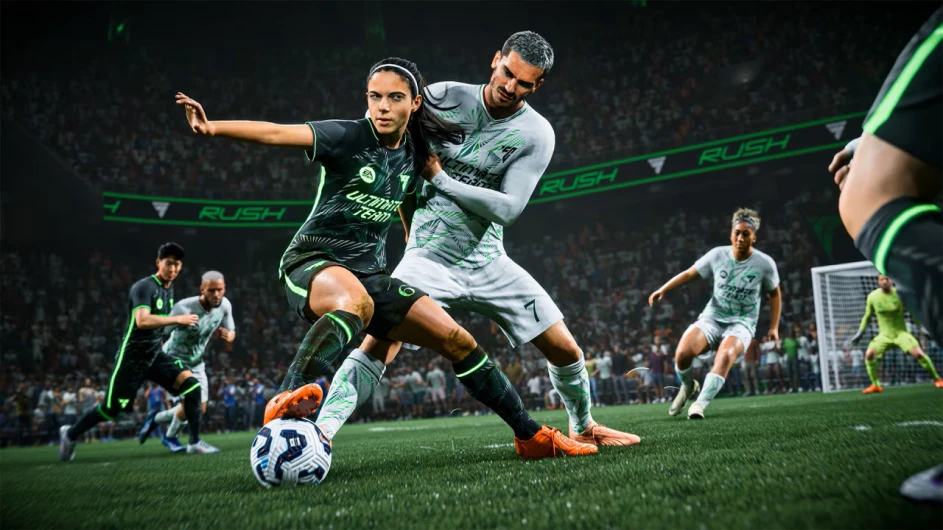
FC 25 Dribbling Secrets: Master Quick Turns Like a Pro
- Eliminating Common Dribbling Mistakes in FC 25
- Why a Good First Touch Sets Up Elite Dribbling
- Avoiding Contact is the Key to Effective Dribbling
- The Secret to Quick Turns: Left Analog Mastery
- Using Analog Inputs to Outsmart Defenders
- Real Gameplay Examples: Analog Timing in Action
- Why Dribbling Isn't Meta in FC 25 (But Still Useful)
- Conclusion: Dribble With Intent and Intelligence
Are you tired of sluggish turns and clunky ball control in EA Sports FC 25? There's a dribbling trick that top-tier players use to maintain fluidity and beat defenders effortlessly and it’s finally time to reveal it. This game-changing technique can revolutionize how you handle quick turns and ball retention under pressure. It’s not widely known, and many pro players would rather keep it to themselves. But in this breakdown, you’ll learn exactly how to do it. If you want cheap, secure, and fast FC 25 coins to build your dream squad, check out u7buy.com and use code DRFC for a 5% discount.
From the earliest version of FC 25, many players noticed dribbling felt slower and less responsive. Yet somehow, elite-level players are able to make razor-sharp turns and dance around defenders with ease. The secret isn't in flashy skill moves or OP mechanics—it’s in how you use the left analog stick while dribbling. This subtle but powerful trick can dramatically increase your in-game efficiency. But before we dive into the left analog magic, we need to go back to the basics of dribbling in FC 25 and understand what’s holding most players back.

Eliminating Common Dribbling Mistakes in FC 25
Dribbling starts with control, and unfortunately, many players sabotage their dribbling by making basic errors. One of the most common mistakes is controlling the ball while sprinting. When you hold the sprint button, your player takes heavier touches, making it far easier for a nearby defender to intercept. This gives your opponent an opportunity to lunge in and steal possession before you even begin your attacking move.
Another frequent error is directing the ball toward pressure instead of away from it. So many players unknowingly steer the ball straight into a defender’s path, essentially handing them the ball. The fix? Always control the ball away from the opponent and ensure your player’s body is positioned between the ball and the defender. This makes it harder for them to make clean tackles and helps you maintain possession longer.
Why a Good First Touch Sets Up Elite Dribbling
One of the key pillars of effective dribbling is a clean, composed first touch. A well-executed first touch sets the tone for the entire attacking sequence, letting you maintain close control and keep defenders guessing. In FC 25, where space can be tight and defenders are aggressive, having a soft first touch can give you the time needed to assess your next move whether it's a quick turn, pass, or drive forward.
To optimize your dribbling, avoid sprinting unless you're in open space. Sprinting should be used strategically, not constantly. Keeping close ball control allows your player to react faster and be more agile in confined areas. This is especially important in the final third, where you need to weave between defenders and keep the ball glued to your feet.

Safe Dribbling vs. Risky Dribbling in FC 25
Safe dribbling is one of the most effective yet overlooked strategies in FC 25. It’s all about shielding the ball and positioning your body smartly. The idea is to always place your player between the defender and the ball, making it difficult for opponents to get a clean tackle in. This method of “body-block dribbling” has been a consistent strategy over the last few FC titles, and it still holds up well in FC 25.
However, there's a twist this year—defenders in FC 25 can sometimes poke the ball away from behind, even when you're shielding it. That means simply using your body isn't always enough. You’ll need to stay mobile, adjust your angles, and use the analog stick to maintain constant movement. It’s not just about protecting the ball—it’s about doing so while staying one step ahead of your marker.
Avoiding Contact is the Key to Effective Dribbling
This year, avoiding physical contact with defenders is more important than ever. Instead of forcing your way through challenges, the meta revolves around evasion constantly moving away from your opponent’s reach and changing directions on the fly. This isn’t about using skill moves or flashy flair it’s about understanding spacing and reaction timing.
When dribbling in FC 25, always try to maneuver into open space rather than engaging in direct duels. Shift directions quickly and avoid staying static for too long. Keep your eyes on the defensive line and use lateral movements to create passing angles or buy time. Once you understand this fundamental principle, you’re ready to learn the advanced technique that takes your dribbling to the next level.
![]()
The Secret to Quick Turns: Left Analog Mastery
Here’s where the real magic happens. Quick turning in FC 25 isn’t just about the player’s stats it’s about how you manipulate the left analog stick. Most players wait for their in-game character to fully turn and face a new direction before adjusting the analog. That’s a mistake. The trick is to preemptively change your analog direction even before your player completes the turn animation.
Think of it like steering a car: you want to start turning the wheel before the corner, not during it. This gives your player momentum to change direction much faster than if you wait for them to shift their body. You can see this clearly when controlling players like Valverde who isn’t even among the top dribblers but still manages to make silky-smooth directional changes with this analog technique.
Using Analog Inputs to Outsmart Defenders
Let’s put this into action. Say you're dribbling down the wing and you point the analog downward. Just before your player completes the turn and faces that direction, flick the analog up. What happens? Your player reacts faster and starts turning before finishing the last animation. This pre-input movement creates lightning-fast direction changes, which completely throw off defenders expecting standard dribbling.
Even without elite dribblers, you can make sharp turns and fake outs using this left analog trick. And if you combine it with top-tier ball handlers like Neymar, Messi, or Vinicius Jr., the effectiveness skyrockets. The key is timing change analog directions slightly ahead of the player’s body orientation, and you’ll create deceptive, fluid motion that’s almost impossible to defend.
Real Gameplay Examples: Analog Timing in Action
Watching real gameplay examples helps solidify this technique. In one instance, as soon as a winger receives a pass, the analog is already pointing to one direction. Before the player fully controls the ball, the input changes again, forcing a quick turn that completely breaks the opponent’s defensive line. It’s subtle, but it gives you that split-second edge needed to stay one step ahead.
When you combine these quick flicks with natural dribbling paths—like using the touchline for curved sprints or drifting centrally to draw defenders you maximize your unpredictability. Try to mix up your analog inputs and keep the opponent guessing. With a bit of practice, these dribbling turns will become second nature and give you a major advantage during intense matches.
Why Dribbling Isn't Meta in FC 25 (But Still Useful)
It’s important to understand that dribbling, while effective, isn’t the central meta of FC 25. The game heavily rewards precise passing, quick build-up play, and exploiting space through through-balls and lobbed passes. That’s why most pro players prioritize passing techniques over dribbling in competitive play.
However, dribbling still has value, especially in specific situations. Use it when you're isolated on the wing, being tightly pressed, or trying to fake out an opponent to create space. Dribbling with purpose—not just for flair—can lead to better ball retention, improved passing lanes, and unexpected goal-scoring opportunities.

Conclusion: Dribble With Intent and Intelligence
The most important takeaway from this guide is this: don’t over-dribble. Always have a purpose behind every turn, shift, or movement. Whether you’re protecting the ball, faking out defenders, or opening up passing angles, make sure there’s intention behind every analog input.
By mastering this quick turn technique and refining your dribbling fundamentals, you’ll become significantly harder to defend in FC 25. Practice the analog timing in matches, watch your gameplay clips back, and continue adjusting based on what defenders are doing. With time, you’ll go from clunky turns to smooth, elite-level ball control. Good luck on the pitch!
We will share more updates on FC 25 in separate articles. If you found this information helpful or would like to learn more, please be sure to explore the other articles on our site.
How Emre Yilmaz Outsmarted the Best to Win the FC 25 eChampions League – Step-by-Step Breakdown
Mastering the 4-4-2 (2nd Variation): Ultimate Custom Tactics for High-Level Play



